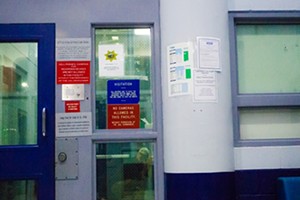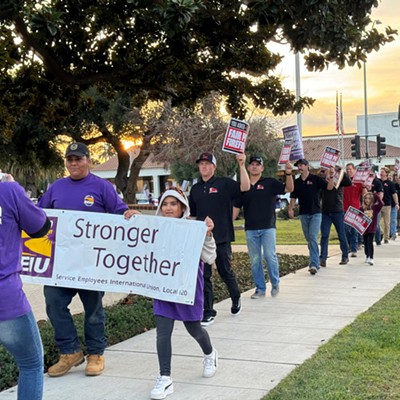It was almost midnight, Dan was 7 miles from home, and all he had was his wheelchair. He didn’t have a phone, money, or a coat.
He had just spent almost all of Aug. 9 in Santa Barbara County Jail sobering up, after being caught, yet again, drinking a beer on West Carrillo Street in Santa Barbara when most people were just heading to work.
Now, it was time for Dan to make the journey home to the park downtown where he usually slept. But buses in the county don’t run past 9 p.m. and Dan couldn’t pay for a cab. He couldn’t even walk.

Hank Bowis and Douglas Bowman had been waiting in the jail lobby since 10 p.m. The two men, both well dressed and clean cut, looked nothing like the usual guests who inhabit the jail most weeknights. When the men met Dan in the lobby, they asked how he’d get home.
“I guess I’ll roll,” he answered.
Bowis and Bowman are just two of several volunteers involved in Lights On, a Christian program dedicated to helping inmates who are released from the jail between 10 p.m. and 1 a.m. It’s one of the only programs still helping people who are released late at night after spending hours in jail for mostly minor offenses. Sometimes they don’t have money, warm clothes, or a way to get home.
Dan, in every possible sense, was released too late. Too late to catch a bus and too late to catch a ride from the county’s jail ride program, which came to an unannounced end in January.
He ran into Bowis and Bowman on his way out. They were in the lobby following the usual Lights On procedure. They set out snacks, coffee, bottles of water, phones for those without, and chargers for those with dead phones, a frequent issue Bowis said inmates face when released. There were also lists of cab company phone numbers—most inmates don’t have enough money to take a cab—and other resources, including rehab centers, rescue missions, and bus schedules, which yielded nothing but bad news.
Dan gladly accepted the help. The volunteers gave him a hot cup of coffee, a granola bar, and a sweatshirt from their collection of donated clothes.
Bowis, who said Lights On volunteers often buy women cabs home when they are released late, even called a cab and paid $12 of his own money to get Dan to the park.
Bowis said he and other volunteers do what they can to get detainees safely where they need to go, but there aren’t a lot of ways Lights On can help North County residents, who are now taken to Santa Barbara when they get arrested.
After the Santa Barbara County Sheriff’s Office took a $5 million budget cut this year, Santa Maria’s Foster Road jail was closed, leaving North County without a nearby holding facility. Although the North County Jail is scheduled to open in Santa Maria in 2019, North County law enforcement will have no choice but to drive arrestees more than 60 miles to the Santa Barbara County Main Jail until then.
Bowis, who takes careful notes on all the inmates released between 10 p.m. and 1 a.m. Monday through Thursday, estimated that nearly two-thirds of inmates released from the jail are North County residents. Out of four inmates released on Aug. 9, two lived in North County. A woman from Orcutt said she would be waiting alone in the lobby for hours for her ride, and a man from Nipomo said he would be staying with his sister in Goleta for the night, despite her reluctance.
Arrestees, Bowis said, get a county-funded ride to the jail, but they certainly don’t get one back.
Back to the beginning
After years of arguing with legislators and pushing at the Santa Barbara County Board of Supervisors, Peter Marin has become an expert on late-night jail releases.
Marin, a long time activist and founder of the Committee for Social Justice, noticed two decades ago that while many detainees are released from jail during normal business hours, others are released late at night when the buses aren’t running.

While detainees released during the day get bus tokens that allow them to take a bus wherever, individuals released at night get nothing. People who don’t have a phone or money for a cab, which Marin said happens often, are forced to walk along a highway. That is, unless they want to wait in the fluorescently lit jail lobby overnight, which Marin said they have every right to do.
When Marin started the jail ride program in 2009, it was several years before the Foster Road jail was closed and North County residents compounded the issue. At the time, the walk home from jail was seven miles rather than 60, and Marin was still outraged.
The late night walk to downtown Santa Barbara is dark, and for years the road lacked a sidewalk. Since then, other issues have come to light, including the fact that inmates are released in nothing but the clothes they were wearing while arrested.
“So if you were wearing a shirt in the afternoon because it was warm,” Marin said, “and then, they release you at night, especially in the winter when it’s raining or cold, you’ve got nothing but your shirt.”
Marin also said people are frequently arrested in their homes, and police don’t usually give them time to grab a cell phone, money, shoes, or warm clothes on the way out.
The same is true for individuals arrested on the street, according to Sgt. Jesus Valle of the Santa Maria Police Department, who said detainees arrested with large items—bicycles, sleeping bags, etc.—are forced to hand over their property to the police. Valle said the items are stored at the police department, which is not open at night. After individuals released from the jail find a way back to North County, they have to wait until morning to get their large items back.
In fact, Valle said they have to schedule an appointment with the police department. For people like Dan, who was released from jail at midnight on Aug. 9, this meant he would be sleeping outside without his usual blankets and pillows until he could retrieve them from the Santa Barbara Police Department.
Marin has always detested this system. So when the city of Santa Barbara and the county came together in 2009 to work on a program aimed at ending homelessness called Bringing Our Community Home, Marin joined forces with one of its leaders to start the jail ride program.
At that time, the program was funded entirely by private donors. A limousine company called Rock Star Transportation sent cabs to the jail late at night whenever it was called. The cabs, Marin said, only dropped people at a few locations: the bus or train station, rescue missions, and rehab centers.
At the end of each month, the company submitted an invoice and Marin paid the company through his donors. The Sheriff’s Office cooperated with the program, Marin said, but had no other involvement.
After years of running the jail ride program smoothly, Marin said he grew tired of managing a service that he felt should be the county’s responsibility.
“I’m old,” Marin said. “I don’t want to do it.”
He eventually presented the program to the Board of Supervisors, which voted to have the Sheriff’s Office take control of it in 2014.
As far as Marin knew, everything with the program was running smoothly until about a month ago, when Marin accidentally discovered that the program had come to an end after Rock Star Transportation went out of business in January. Marin asked about the program’s end at a supervisors meeting in July, expecting to hear some answers.
Instead, supervisors responded with total confusion. They had not been told that Rock Star Transportation went out of business or that the jail ride program had come to a stop.
After reaching out to Public Information Officer Kelly Hoover for an interview with Sheriff Bill Brown, the Sun was instead passed to Chief Custody Deputy Vincent Wasilewski. *
“We could have told them,” Wasilewski told the Sun. “But we didn’t really have to tell them because they don’t control the money.”
Getting priorities straight
In fiscal year 2014-15, supervisors agreed to allocate a one time amount of $10,000 to the Sheriff’s Office to fund the jail ride program. Wasilewski said the money was meant to help the Sheriff’s Office adapt to funding the program itself. He said that was the only time the board funded it.

From 2015 to 2016, Wasilewski said the rides were paid for through Inmate Welfare Funds, the percentage of money the jail keeps when an inmate buys anything from the commissary. Inmates can buy things like snacks and shampoo at the commissary, and the Sheriff’s Office keeps a small percentage of every sale. That money goes to the Inmate Welfare Fund, which must be used to improve inmate quality of life in the jail.
Wasilewski said the Sheriff’s Office uses that money to pay for anything the jail isn’t legally required to provide. Food and uniforms, for example, are things the jail must provide. Instead, Inmate Welfare Funds are used to pay for things like vocational programs and, last year, the jail ride program. The program cost the Sheriff’s Office $14,440 last year, according to Wasilewski, and that includes the cost of the bus tokens provided to inmates who are released during the day.
Rock Star Transportation notified the Sheriff’s Office in January that it was going out of business, Wasilewski said, and the office has been searching for another transportation company to take over. Wasilewski said the Sheriff’s Office contacted several local and major cab companies, none of which expressed interest in the program. He declined to tell the Sun the names of those companies.
Wasilewski wouldn’t say why the cab companies didn’t want to provide jail rides either, although he did say that they would have to sign a contract and wait to get paid until the end of each month. Legally, the Sheriff’s Office can’t call a cab when an inmate is released late at night.
“It’s the way the auditing goes,” Wasilewski said. “It can’t just be this open ended thing where they can just charge as much as they want. And they did not express interest in this.”
For now, Wasilewski said the Sheriff’s Office is doing everything it can to reduce the number of late-night releases from the jail. The biggest change is in the way the office processes paperwork.
Courthouses around the county send the jail all kinds of paperwork relating to detainees, including the documents for release. Sometimes, Wasilewski said, those documents don’t get to the jail until as late as 6 p.m. In the past, the jail would process the paperwork in order of arrival. Now, he said, they process all releasing documents immediately so that inmates can leave as early as possible.
Still, Wasilewski said it’s impossible to avoid late-night releases entirely.
For some detainees, paperwork isn’t the issue. Many people in jail are simply there because they didn’t meet a certain legal standard while being cited. If a person doesn’t have identification or is intoxicated while being cited for a minor offense, an officer will detain that person until their identity is verified or they sober up.

It’s often late at night when inmates reach sobriety, Wasilewski said, and the jail is legally bound to let them go.
“It’s a very small number of folks who have no way of getting back to downtown, and we try to accommodate them,” Wasilewski said. “This program has hit a wall but we’re not stopping. We’re going to come up with a solution somewhere. We certainly don’t want to stop this program and we didn’t have any intention to do that.”
Santa Barbara County 5th District Supervisor Steve Lavagnino said the supervisors fully intend to ensure that the jail ride program is up and running again as soon as possible. But the issue of getting North County inmates to their hometowns has not been fully addressed.
Supervisors recently met with several members of North County law enforcement to discuss a more efficient system for getting North County arrestees to jail. Lavagnino said forcing individual officers to drive a detainee to Santa Barbara has proven to be a complete waste of resources.
“Each individual city has been driving [inmates] down there,” Lavagnino said. “So we actually had North County police from different jurisdictions passing each other on the way.”
Lavagnino said the meeting ended with leaders deciding that a bus system will transport all arrestees from North County to the jail for booking during the 18 months until the new jail is opened. But a solution to how North County residents will get back home at night, Lavagnino said, has not been found.
“I think it’s the sheriff’s responsibility. It’s part of the whole jail environment, so I think he’s the best person to determine who will be the vendor,” Lavagnino said. “It’s not a budget thing; it’s not a money issue. It’s getting [a cab company] that will step up and do it. I know they’ve talked to Uber and that didn’t work either.”
A fresh start
Two days and two phone calls. That’s what it took for jail ride program founder Marin to find another cab company willing to sign a contract and take part in the jail ride program.
Marin said he doesn’t understand why the jail ride program has never been treated as a priority by the Sheriff’s Office or by the community.
“They’re used to thinking of lawbreakers as being antagonists. So why should they be nice to them?” Marin asked. “It’s odd to me. I don’t know why people think it’s OK for indigent people to walk 5 to 7 miles back to town in the rain.”
Marin said the ride program is likely to start back up in the near future, thanks to 1st District Supervisor Das Williams and his staff; Blue Dolphin Cabs of Santa Barbara; and the Good Samaritan Shelter, a nonprofit organization with locations in Santa Maria and Lompoc that Marin said agreed to help run the new ride program. Good Sam was also involved with the former program.
A nonprofit is required to help the Sheriff’s Office run the program for insurance reasons, Marin said. Blue Dolphin will sign a contract with Good Sam, and Good Sam will provide the appropriate insurance and pay the cab company to make several nightly stops at the jail. Then at the end of each month, Marin said the Sheriff’s Office will reimburse Good Sam.
“The Sheriff’s Office could have done this, and they didn’t for some reason I don’t understand,” Marin said. “The jail has had its budget cut and they struggle to keep up with everything. You often can’t separate inefficiency from intentionality.”
But the contract isn’t signed yet. Cameron Schunk, media advisor to Williams, said a formal discussion between the cab company, Good Sam, and the Sheriff’s Office has not been carried out but a meeting will be scheduled as soon as possible.

Schunk said the program’s restart date should be set once all parties meet.
Ken Taylor, the owner of Blue Dolphin Cabs, said he helped Rock Star Transportation with the original jail ride program. Rock Star was a limousine company, Taylor said, so when it needed cabs for the jail ride program, Taylor’s cabs would make nightly stops at the jail.
Taylor said he was one of the few people who knew Rock Star was going out of business in January. He said he agreed to take responsibility for the jail ride program and told the Sheriff’s Office to call his billing department to work out a deal. That was months ago.
He said his billing department never received a phone call.
This, Taylor said, could possibly be because of the company’s recent merge with Yellow Cab in Ventura. The billing department, based in Santa Maria, had several new employees at the time. Maybe the phone call was lost in the mix of inexperience, he said.
Now, he’s waiting patiently for the final meeting to sign the contract. Taylor said he doesn’t know why other transportation companies would hesitate to take over the program.
“We’re in the taxi service business,” Taylor said. “The more business we get, the better.”
Until the contract is signed, Lights On will remain one of the only services provided to detainees released at night. Volunteer Bowis estimated that an average of 15 people are released each weeknight and that the number of North County residents passing through has increased drastically since Santa Maria’s jail closed.
Bowis said he’s helped people from Lompoc and Santa Maria who don’t speak any English, women released alone in the middle of the night, and homeless people who don’t have anyone to call.
Many of the people released at night are alcoholics who need treatment rather than jail time, and Bowis hopes to open a rehabilitation facility for frequent detainees in the future. For now, Bowis said he’d like to see people like Dan, a physically disabled homeless man who was released from jail just before midnight, treated with a little more compassion.
“It’s a human right,” Bowis said. “They got picked up somewhere and taken here, right? So the courteous thing would be to bring them back.”
Staff Writer Kasey Bubnash can be reached at [email protected].
* Editor's note: This article was edited for accuracy. Aug. 17, 2017










